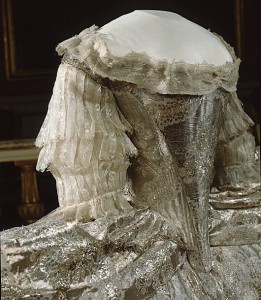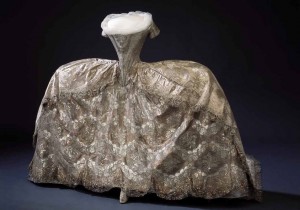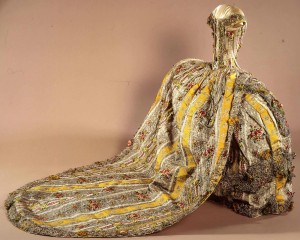I thought it would be helpful to those making 18th century court gowns for next year to do some posts about the basics. My interest in 18th century court wear is in the French styles, so I’ll mostly be blogging about those, but I’ll try to include some info on what was worn in other countries (and link to your posts about these topics, so please feel free to post away!).
By the 18th century, women’s court dress had become standardized, with women wearing clothing that was different from the current fashion. The styles were based on fashionable attire from the late seventeenth century, which King Louis XIV preferred. This style remained required for formal court occasions until the end of the eighteenth century, when things changed… but that’s another post!
So what did French women’s court dress look like for most of the eighteenth century? The grande habit was composed of three elements: the grande corps or corps de robe, the jupe, and the queue.
The Grande Corps/Corps de Robe
The “formal bodice” or “dress bodice” was a boned bodice (in other words, no separate stays — the boning was built into the bodice) with a high off-the-shoulder neckline and a pointed, tabbed waistline. The sleeves were elbow length and made up of pleated lace, with short wings on the top of the armscye.


The Jupe
The “skirt” was wide and worn over huge paniers. I’ve seen references to “medium paniers” and “large paniers,” so obviously there was some room to maneuver (ha ha).

The Queue
The queue was an immensely long train, separate from the skirt, that attached at the waist.

As you can guess from the Swedish dresses, French court dress provided the prototype for court dress across Europe… but some countries (most notably England) wore different styles. More on those, and the fiddly aspects of the French styles, in the coming weeks/months! This is just a primer.
Sources
Fastes de Cour et Ceremonies Royales: Le Costume de Cour en Europe, 1650-1800
20,000 Years of Fashion The History of Costume and Personal Adornment by Francois Boucher
Isis’ Wardrobe: How to make a robe de cour in six weeks and hopefully not go crazy, part 2
Question (& feel free to slap me down if this is something you’ll cover later) – a lot of the fashion plates make the skirts look more round than the flat rectangular shape seen in the extant gowns. Is this just artistic license or were there different styles needed different under-structure shapes? Bec. some of them look almost like there’s a round hoop worn under the gown, not side panniers, or maybe some weird cross-breed between the two. Or maybe it’s the same panniers with really fluffy petticoats that round out the look. Or again, artistic license!
No, that’s a very good question! Off the top of my head, I wonder if it’s differences between eras and countries, but I’ll add it to my list of “things to look into more.”
Oh, I really need to pull myself together and finish mine now! I got an aversion against my cover fabric and haven’t a clue of what I want instead!
From what I have found about the shape of the panier, both time and country mattered. The earliest of the court gowns in Sweden is extremely boxlike and the skirt contruction differs from the others, it is boxlike too, while the later get a bit more bell-shaped. I can dig up my source, if you want, I Think it is in a Swedish book on courtwear, that says that Sweden favoured the box more than the bell.
Isis: Yes, please dig up that info! Would love to see what you have.
I don’t think I’m going to end up making one of these, but I’m really looking forward to seeing how everyone maneuvers around each other at Costume College.